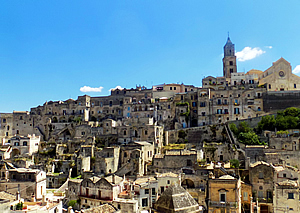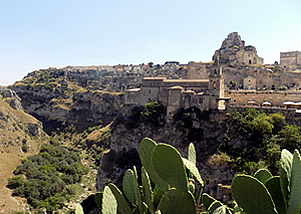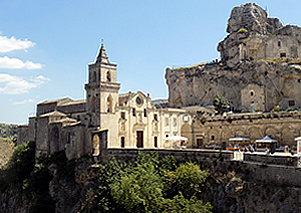Matera
Ostuni
- Origins of Ostuni
- What to see in Ostuni
- Events in Ostuni
- Practicalities
- Seaside of Ostuni
- Masserie of Ostuni
- Trulli
- Museum of Ostuni
- Parks and protected areas
- Cuisine
- Images of Ostuni
- Ostuni local info
- Getting to Ostuni
Rentals
Services
- Property and land management
- Guest management
- Property restoration and reparing works
- Taxi service and taxi sharing service
- Services for disabled
Excursions
Food & Wine

The city of Matera, known as "The City of the Sassi", has been a UNESCO World Heritage Site since 1993, thanks to its renowned ancient old town: the "Sassi di Matera" cave dwellings, and to the Park of the Rupestrian Churches.
The ancient city grew on the slope of a rocky ravine created by a river, now a small stream, locally known as "La Gravina".
Origins of Matera

The origins of Matera can be traced back to the Palaeolithic period, although its real foundation dates back to the 3rd century BC, during the Roman period, when it was called Matheola.
After the fall of the Roman Empire, Matera was conquered by the Longobards, becoming part of the Duchy of Benevento.
Between the 7th and 8th centuries, the caves started to be inhabited by Benedictine and Basilian monks who settled in the area. In the 9th and 10th centuries, Matera was involved in the struggle between the Byzantines and the German Emperors, which resulted in the partial destruction of the city.
Later, Matera was conquered by the Normans, by the Aragonese and then became part of the Terre d'Otranto of Puglia.
Matera Tourist Info Office
Address: Via Ridola, 67/A
Phone number: +39 0835 311655
Distance from Ostuni: 141 km
Time to get there by car: about 1 hour and 45 minutes
Time to get there by train: from Ostuni to Bari - 1 hour - from Bari to Matera - 2 hours
What to see in Matera
The Sassi
The Sassi of Matera, considered to be among the first settlements inside the Italian territory, are a group of caves, both natural and man-made, converted into dwellings. The houses were built by digging deeper into the rock, with streets and more caves above them, and some roads running to the highest point of these overlapping dwellings.
Sasso Barisano
Sasso Barisano is an area of the Sassi of Matera located to the south of the Gravina. Here, one of the largest churches excavated in the rock can be found: the Church of San Pietro Barisano. It has an 18th-century façade and a pointed bell tower. Here, you will also find the Church of Our Lady of Virtues, built between the 10th and 11th centuries, and the Baroque Church of S. Agostino, built in 1591.
Sasso Caveoso
The u-shaped Sasso Caveoso is located on the northern part of the ravine. In this area of the Sassi, the houses are almost completely excavated in the rock.
Cattedrale di Matera

The 13th century Romanesque Cathedral of Matera, dedicated to Santa Maria della Bruna was built on the highest point between Sasso Barisano and Sasso Caveoso.
It has a 52 metre tall bell tower and a stunning rose window, divided by sixteen small columns, on the façade. The interior is predominantly Baroque, but some religious art from earlier periods has survived, such as a beautiful Byzantine fresco of the Madonna della Bruna, a fresco depicting the Universal Judgement, and a 16th century nativity scene made by the sculptor Persio.
Convento and Chiesa di Sant'Agostino
The Convent of Sant'Agostino, located in the area of Sasso Barisano, was built in 1593 by the monks of the order of the Eremitani. The building was erected above an ancient 12th century rock crypt dedicated to San Guglielmo. The monks also belonged to the convent of the nearby Church of Santa Maria delle Grazie.
The façade of the church of Sant'Agostino is in late Baroque style, on two levels. Inside a niche, located on the main portal, is a statue of Sant'Agostino. The interior has a Latin cross shape with a single nave decorated with a series of elaborate stone altars on each side.
Chiesa di San Giovanni Battista
The Church of San Giovanni Battista was built in the 13th century. Although mainly a Romanesque structure, it also has Arabic style portals and Gothic style arches.
The main portal, located on one side of the church, is finely decorated with plant motifs and adorned animal sculptures.
The interior of the church has three naves. The ceiling of the central nave was rebuilt in 1793. There are also a series of medieval chapels with interesting frescos and statues.
Chiesa di San Francesco d'Assisi
The Church of San Francesco d'Assisi, located in Piazza San Francesco, was built over an ancient hypogeum church, where an ancient fresco of 1093, depicting a visit to Matera of Pope Urban, can still be admired.
The church has undergone various changes over the centuries, until its present Baroque appearance from the 18th century. The interior consists of a single nave with a painted ceiling.
Chiese rupestri
There are several fascinating rock churches to see in Matera and inside the Gravina del Parco della Murgia such as: Santa Lucia alle Malve, Santa Maria di Idris, Santa Barbara, San Pietro Barisano and the Church of Santa Maria della Valle.
Palazzo dell'Annunziata
The 18th century Palazzo dell'Annunziata is located in Piazza Vittorio Veneto. This palace was originally built as a monastery for Dominican nuns. In 1865 it became a court of law, later a school. Today it houses a multimedia library and a cinema.
Palazzo Lanfranchi
Palazzo Lanfranchi, now home to the National Museum of Medieval and Modern Art, is a 17th century palace, built by Frate Francesco da Copertino to house a diocesan seminary. The lower part of its asymmetrical façade has two portals, and is decorated with statues of saints in niches and of the Madonna del Carmine over the left entrance. The upper part consists of blind arches, the largest one encircling a rose window, just above the statue of Madonna del Carmine, and an ornamental pediment with a large clock.
Palazzo del Sedile
The Palazzo del Sedile, home of the Conservatory of Music "Egidio Romualdo Duni" and the Auditorium Gervasio, is located in the central Piazza del Sedile.
This building from the 1540's has a façade with a large arch and two bell towers. On either side of the arch, there are niches containing statues of Sant'Eustachio and Madonna della Bruna, patrons saints of Matera, and four other statues, which represent justice, fortress, temperance and prudence.
Chiesa San Pietro Caveoso

The church of San Pietro Caveoso, also known as Church of Saints Peter and Paul, dates back to the 13th century, although it has undergone various changes over the centuries. The current Baroque style fa&ccdeil;ade and the adjacent bell tower date back to the 17th century.
The church has three portals: the central one is surmounted by the statues of the Madonna and the ones on the sides by the statues of the saints Peter and Paul. Inside a wood carved golden altar and a decorated ceiling can be admired.
Ostuni
- Origins of Ostuni
- What to see in Ostuni
- Events in Ostuni
- Practicalities
- Seaside of Ostuni
- Masserie of Ostuni
- Trulli
- Museum of Ostuni
- Parks and protected areas
- Cuisine
- Images of Ostuni
- Ostuni local info
- Getting to Ostuni
Rentals
Services
- Property and land management
- Guest management
- Property restoration and reparing works
- Taxi service and taxi sharing service
- Services for disabled
Excursions
Food & Wine







